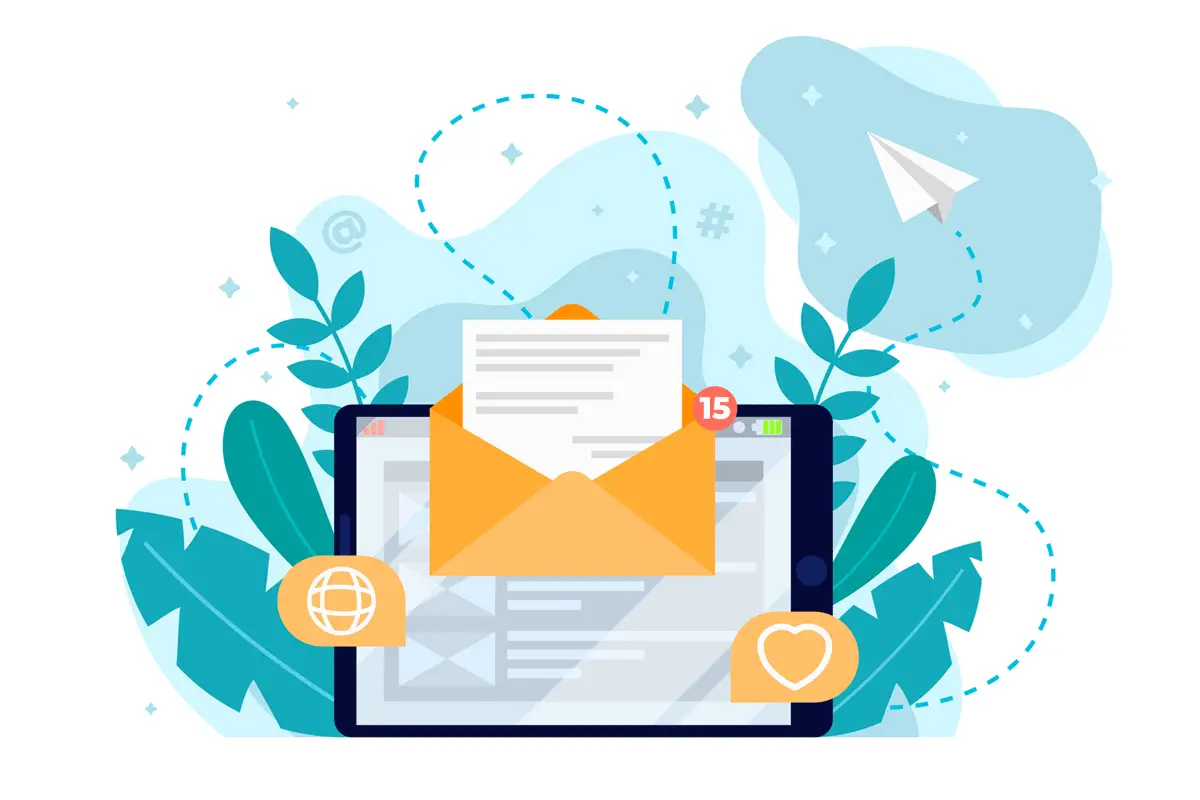Email marketing is a powerful tool that can enhance your digital marketing strategy. This guide will help you understand the basics of email marketing for beginners and how it can connect you with your audience effectively. You’ll learn essential tips for collecting email lists, crafting compelling campaigns, and tracking your success.
Get ready to elevate your marketing efforts and engage your customers!
Understanding Email Marketing
Email marketing is a powerful tool in your digital marketing strategy. It helps you connect with your audience, build brand awareness, and drive sales through targeted communication.
The Role of Email in Digital Marketing
Email serves as a direct line of communication between you and your audience. Unlike social media, where posts can get lost in feeds, emails land directly in your inbox.
Building an email list is essential. This list consists of people who have opted to receive your messages, making them more likely to engage.
Personalization plays a crucial role here. When you send tailored content, your audience feels valued. This increases their likelihood of opening emails and clicking links.
Moreover, emails can nurture prospects into loyal customers. Following up with tailored content keeps your brand top-of-mind.
Benefits of Email Marketing
Email marketing offers several benefits that can significantly impact your business.
Cost-Effectiveness: Compared to other marketing channels, email marketing is budget-friendly. You can reach thousands of people without spending a fortune.
High ROI: Many businesses report high returns on their email campaigns. For every dollar spent, the return can be substantial.
Improved Engagement: Well-crafted emails encourage interaction. High open and click-through rates are often seen with targeted campaigns.
Brand Awareness: Consistent email communication helps keep your brand in the spotlight. Regular updates remind your audience of your products and services.
Drive Sales: Email campaigns can lead directly to sales. Promotions, special offers, and personalized recommendations increase the chances of purchases.
Here’s a quick summary in a table format for easy reference:
| Benefit | Description |
|---|---|
| Cost-Effectiveness | Low cost to reach many people |
| High ROI | Potential for great returns on investment |
| Improved Engagement | Higher interaction rates through targeted content |
| Brand Awareness | Keeps your brand in the minds of your audience |
| Drive Sales | Promotional emails can lead to immediate purchases |
Building Your Email List
Creating a strong email list is a vital step in your email marketing strategy. It involves gaining new subscribers and organizing them effectively. This will help you connect with your audience in a meaningful way.
Acquiring New Subscribers
To grow your email list, you need to attract new subscribers effectively. Use several tactics to turn visitors into email subscribers:
- Lead Magnets: Offer something valuable, like a free download, checklist, or guide in exchange for their email address. This entices users to sign up.
- Forms: Place sign-up forms in key locations on your website. Use pop-ups, landing pages, or a dedicated section in your blog posts. Make sure the forms are clear and easy to fill out.
- Special Offers: Consider offering exclusive discounts or promotions for subscribers. This can make joining your list more appealing.
- Webinars and Podcasts: Hosting a webinar or a series of podcasts can also draw interest. Ask attendees to subscribe for updates or additional resources.
Engaging potential subscribers through valuable content is crucial. When they find value, they are more likely to join your list.
Email List Segmentation
Once you’ve built your email list, segmenting it helps you send targeted messages. This improves engagement and response rates. Here’s how to segment your email subscribers:
- Demographics: Use information such as age, location, and interests. This allows you to tailor your messages more effectively.
- Behavior: Track how subscribers interact with your emails. For example, segment those who frequently open your emails versus those who do not.
- Engagement: Create groups based on how often they engage. Some might prefer regular updates, while others may want less frequent communications.
Segmenting your list enables you to send personalized content. This strategy improves your marketing effectiveness and helps build stronger relationships with your subscribers.
Crafting Effective Email Campaigns
Creating successful email campaigns requires careful attention to design, content, and call-to-action (CTA) strategies. These elements help ensure your message reaches your audience effectively and encourages engagement.
Designing Appealing Newsletters
A well-designed newsletter grabs attention and keeps readers interested. Start with a clean layout that uses plenty of white space. This makes the email easy to read on both desktop and mobile devices.
Choose a color scheme that reflects your brand. Use bold headlines to highlight key sections. Incorporate images that complement your message, but be careful not to overload the email with visuals. Keep the design consistent across all emails in your campaign.
An effective email template will save you time and maintain a professional appearance. You can also create sections for promotions, news, and testimonials, allowing users to find the information they need quickly.
Creating Engaging Content
Your email content needs to be relevant, interesting, and valuable to your audience. Start with a catchy subject line that piques their curiosity. This encourages higher open rates.
Keep the message concise and to the point. Use bullet points or lists to break down important information. This helps readers absorb the material without feeling overwhelmed.
Personalization plays a crucial role in content engagement. Use the recipient’s name and tailor the content to their preferences. Including targeted emails based on past interactions can significantly enhance engagement.
Using CTAs Effectively
CTAs guide subscribers toward the next step you want them to take. These could be signing up for an event, visiting your website, or making a purchase. Make sure your CTAs stand out by using bold colors and clear wording.
Position your CTAs logically within the email. Typically, one to two CTAs per email are ideal to avoid overwhelming readers. Use action-oriented language like “Get Started” or “Learn More” to encourage clicks.
Test different CTA placements and styles to see what resonates best with your audience. Tracking clicks can provide valuable data for optimizing future campaigns.
Enhancing Performance and Measuring Success
To improve your email marketing efforts, you’ll want to focus on optimizing campaigns and tracking key metrics. These steps will help you engage your audience better and measure your success effectively.
Optimizing Email Campaigns with A/B Testing
A/B testing is a crucial method for optimizing your email campaigns. This process involves sending two variations of an email to different segments of your audience to see which performs better.
When running A/B tests, consider what to change. Options include subject lines, email copy, images, and call-to-action buttons. For example, try different subject lines to see which achieves a higher open rate.
After sending out the variations, compare the results. Look at open rates, click-through rates, and conversions. Use the data to guide your future campaigns. This approach not only boosts engagement but also enhances overall campaign success and ROI.
Tracking and Analyzing Key Metrics
Measuring the success of your email marketing hinges on tracking key metrics. Focus on important statistics such as open rates, click-through rates, and conversion rates.
- Open Rate: This shows the percentage of recipients who opened your email. A higher open rate indicates effective subject lines.
- Click-Through Rate (CTR): This metric tells you the percentage of recipients who clicked on links in your email. It’s essential for gauging engagement levels.
- Conversion Rate: This indicates how many recipients completed the desired action, whether that’s signing up or making a purchase.
Keep an eye on the unsubscribe rate as well. A high unsubscribe rate may signal issues with content relevancy. Collect feedback from your audience to refine your approach and improve email engagement over time. Use analytics to determine what works best for your audience, maximizing your email marketing revenue.
Leveraging Technology for Email Marketing
Using technology effectively can greatly enhance your email marketing efforts. Two key areas to focus on are selecting the right email marketing platform and automating your email campaigns for better efficiency.
Choosing the Right Email Marketing Platform
Selecting the right email service provider (ESP) is crucial for your marketing success. Popular options include HubSpot and Mailchimp. When choosing an ESP, consider the following features:
- User-Friendly Interface: Look for platforms that are easy to navigate.
- Templates: Choose one that offers customizable templates for different types of campaigns.
- Analytics Tools: Ensure that it provides detailed performance reports to improve your strategies.
A good email marketing tool should also support list segmentation and managing subscriber data effectively. This helps tailor your messages and maximize engagement.
Automating Email Campaigns for Efficiency
Email automation can save you time and increase the effectiveness of your campaigns. With email marketing automation, you can create email workflows that trigger specific responses based on user behavior. For example:
- Welcome Emails: Send automatically when someone subscribes.
- Follow-Up Emails: Triggered after an initial purchase or interaction.
Setting up these triggers allows you to maintain regular contact without manual effort. Tools like HubSpot and Mailchimp offer user-friendly automation features to help you streamline your marketing campaigns and engage with your audience effectively. By leveraging these technologies, you can focus on growing your business while ensuring that your email communications remain consistent and impactful.

SEO Chatter is dedicated to teaching the fundamentals of search engine marketing to help marketers understand how to increase organic website traffic and improve search engine rankings.

